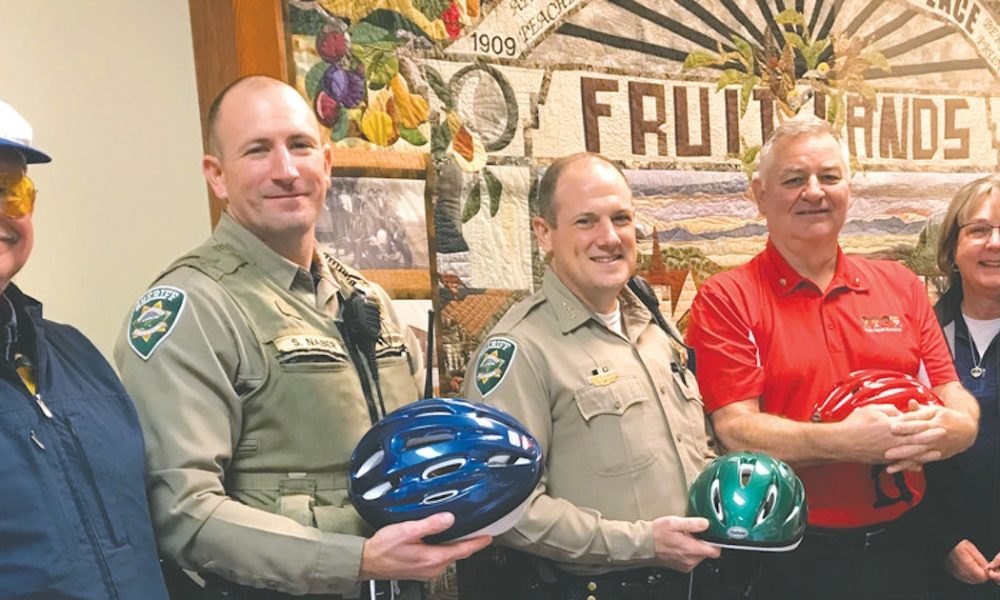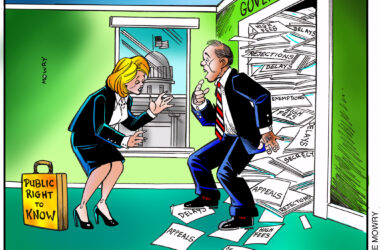 Kiwanis Club members present Sheriff Harrold with 47 bike helmets for distribution to area youth in Creswell. Above, from left: Larry Schrenk, Deputy Steve Naber, Sheriff Cliff Harrold, Don Ehrich, Roberta Tharp, Carolyn Allen.
Kiwanis Club members present Sheriff Harrold with 47 bike helmets for distribution to area youth in Creswell. Above, from left: Larry Schrenk, Deputy Steve Naber, Sheriff Cliff Harrold, Don Ehrich, Roberta Tharp, Carolyn Allen.
CRESWELL – Let’s get a few things straight, right from the top.
He’s not Andy Griffith, Lane County isn’t Mayberry, and this sure as heck ain’t the 1950s.
No, our sheriff faces real-world bad guys and actual bullets, patrols more than 4,700 square miles from the mountains to the ocean, and fights criminals who increasingly are using cutting-edge technology to commit their evil deeds.
Granted, his ”aw shucks” demeanor and calm, reassuring and authentic style is reminiscent of a certain small-town TV sheriff. And he is self-deprecating. All right, I’ll admit the sheriff is, simply, likeable.
His youth indicates a vitality and radiates hopefulness, and both came through in his message during a presentation and extended question-and-answer period in front of a packed house at Los Cabos Mexican Restaurant last week.
Over a lunch of pollo a la parrilla, beans and rice, tortilla chips with verde sauce, burritos, tacos and enchiladas, Creswell’s Coast Fork Kiwanis club members ate it up.
The sheriff is one of their own, born and bred in Creswell, encouraged to join the cadet program in high school, mentored by deputies who are now wisened men and women, many retired but still supportive.
Harrold mentions all of their names as he shares his career journey, and they roll off his tongue naturally because he’s not giving a speech, he’s recalling the actual events of his life, with the characters of his childhood, such as ”Mr. Spencer” who ”delivered fuel to the farm.”
Like most children who grew up on a farm, young Cliffton put in his hours toiling in morning darkness and until the sun set. Why isn’t he following in the proverbial family footsteps? ”It’s really hard work,” he says, earnestly, dismissing the life-and-death scenario he walks into each day in his career of choice.
In fact, it was at the end of one of those long summer days working on the dairy farm that he felt certain that was NOT his future.
And it was after an utterly forgettable ride-along a few months later that he was certain that becoming a law enforcement officer WAS his future.
”I knew – after a very routine shift when nothing really happened – that this is what I want to do with my life,” he said. And you know it’s true.
More than two decades later, he says he’s more surprised than anyone to be in his current position, and ”is still getting used to the idea” of being sheriff.
He has learned what it means to be the ”Man in Charge.” Or, rather, he learned what it doesn’t mean.
For instance, you don’t have to do everything, make every decision, fix every problem. He realized, with the benefit of counsel and support from his wife, that his pace wasn’t sustainable, wasn’t healthy. Oh, and his kids missed him.
Harrold said the pressure to perform was his own, and when he stopped to catch his breath, he realized there was more to life than process, workflow and office organization. He admits that he’s still trying to figure it all out; certainly, self-awareness is a starting point. Our sheriff sees clearly. Probably the exact trait you want in your sheriff.
He said he knew that meetings would be a part of a department head’s workday. ”And yet,” flashing slight grin, ”you know, for a guy who loves to get in the car and go help people, who got that immediate sense of fulfillment from ‘going and doing and accomplishing something for someone,’ to what I do now… Yeah, I probably didn’t appreciate the extent of the number of meetings.”
Harrold covered a wide range of topics, from big-picture public safety issues to the newly launched cadet program. A global trend, he said, is that law enforcement jobs are having a hard time recruiting new employees. Perception has obscured the reality of serving, he noted. The cadet program will provide a pathway for people 18- to 21-years-old to learn the ropes of police work.
During the robust Q&A session, he touched on topics from gender diversity on the force to funding concerns.
”Would you explain the stars and stripes on your uniform?” he was asked.
The sheriff nodded, and began to explain the three stars on his collar and the four stripes on his sleeve. You get one stripe for every year on the force, he said, and he is looking forward to receiving his fifth stripe soon.
The three stars on the collar? He explained that several years ago a decision was made to give all sheriffs in Oregon four stars. It was a tad controversial, as chiefs of police receive two stars.
Harrold explained that he’s happy to keep his three stars, and wants to ”grow into” the fourth star. Essentially, he wants to earn it.
A perfect example of the humble ”Man in Charge.”
Noel Nash is publisher of The Chronicle.







